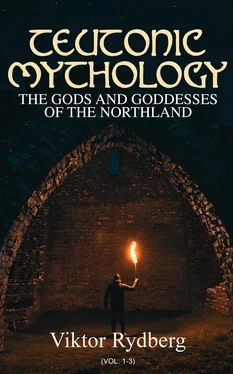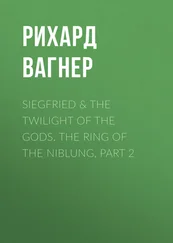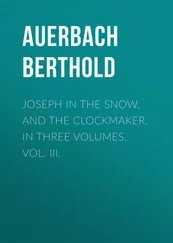(2) That he has performed similar exploits to those of Skjold, the son of Scef-Heimdal.
(3) That he is not clothed with kingly dignity, but has a son who founds a royal dynasty in Denmark. This corresponds to Heimdal's son Rig Jarl, who is not himself styled king, but whose son becomes a Danish king and the progenitor of the Skjoldungs.
(4) That he is married to Drott, who, according to Ynglingasaga, is Danp's daughter. This corresponds to Heimdal's son Rig Jarl, who takes a daughter of Danp as his wife.
(5) That his son is identical with the son of Skjold, the progenitor of the Skjoldungs.
(6) That this son of his is called Halfdan, while in the Anglo-Saxon sources Scef, through his son Scyld (Skjold), is the progenitor of Denmark's king Healfdene.
These testimonies contain incontestible evidence that Skjold, Borgar, and Rig Jarl are names of the same mythic person, the son of the ancient patriarch Heimdal, and himself the second patriarch, who, after Heimdal, determines the destiny of his race. The name Borgarr is a synonym of Skjöldr . The word Skjöldr has from the beginning had, or has in the lapse of past ages acquired, the meaning "the protecting one," "the shielding one," and as such it was applied to the common defensive armour, the shield. Borgarr is derived from bjarga (past. part. borginn ; cp. borg ), and thus has the same meaning, that is, "the defending or protecting one." From Norse poetry a multitude of examples can be given of the paraphrasing of a name with another, or even several others, of similar meaning.
The second patriarch, Heimdal's son, thus has the names Skjold, Borgar, and Rig Jarl in the heathen traditions, and those derived therefrom.
In German poems of the middle age ("Wolfdieterich," "König Ruther," and others) Borgar is remembered by the name Berchtung, Berker, and Berther. His mythic character as ancient patriarch is there well preserved. He is der grise mann , a Teutonic Nestor, wears a beard reaching to the belt, and becomes 250 years old. He was fostered by a king Anzius, the progenitor of the Amelungs (the Amalians). The name Anzius points to the Gothic ansi (Asa-god). Borgar's fostering by "the white Asa-god" has accordingly not been forgotten. Among the exercises taught him by Anzius are daz werfen mit dem messer und schissen zu dem zil (compare Rig Jarl's exercises, Rigsthula, 35). Like Borgar, Berchtung is not a king, but a very noble and greatly-trusted chief, wise and kind, the foster-father and counsellor of heroes and kings. The Norse saga places Borgar, and the German saga places Berchtung, in close relation to heroes who belong to the race of Hildings. Borgar is, according to Saxo, the stepfather of Hildeger; Berchtung is, according to "Wolfdieterich," Hildebrand's ancestor. Of Hildeger Saxo relates in part the same as the German poem tells of Hildebrand. Berchtung becomes the foster-father of an Amalian prince; with Borgar's son grows up as foster-brother Hamal (Helge Hund., 2; see Nos. 29, 42), whose name points to the Amalian race. The very name Borgarr , which, as indicated, in this form refers to bjarga , may in an older form have been related to the name Berchter, Berchtung.
23.
BORGAR-SKJOLD'S SON HALFDAN, THE THIRD PATRIARCH.
Table of Contents
The Identity of Gram, Halfdan Berggram, and Halfdan Borgarson.
In the time of Borgar and his son, the third patriarch, many of the most important events of the myth take place. Before I present these, the chain of evidence requires that I establish clearly the names applied to Borgar in our literary sources. Danish scholars have already discovered what I pointed out above, that the kings Gram Skjoldson, Halfdan Berggram, and Halfdan Borgarson mentioned by Saxo, and referred to different generations, are identical with each other and with Halfdan the Skjoldung and Halfdan the Old of the Icelandic documents.
The correctness of this view will appear from the following parallels: [11]
{Saxo: Gram slays king Sictrugus, and marries Signe,
{ daughter of Sumblus, king of the Finns.
{Hyndluljod: Halfdan Skjoldung slays king Sigtrygg, and
1. { marries Almveig with the consent of Eymund.
{Prose Edda: Halfdan the Old slays king Sigtrygg, and
{ marries Alveig, daughter of Eyvind.
{Fornald. S.: Halfdan the Old slays king Sigtrygg, and
{ marries Alfny, daughter of Eymund.
{Saxo: Gram, son of Skjold, is the progenitor of the Skjoldungs.
{Hyndluljod: Halfdan Skjoldung, son or descendant of
{ Skjold, is the progenitor of the Skjoldungs, Ynglings,
2. { Odlungs, &c.
{Prose Edda: Halfdan the Old is the progenitor of the
{ Hildings, Ynglings, Odlungs, &c.
{Saxo: Halfdan Bogarson is the progenitor of a royal
{ family of Denmark.
{Saxo: Gram uses a club as a weapon. He kills seven
{ brothers and nine of their half-brothers.
{Saxo: Halfdan Berggram uses an oak as a weapon. He
3. { kills seven brothers.
{Saxo: Halfdan Borgarson uses an oak as a weapon. He
{ kills twelve brothers.
{Saxo: Gram secures Groa and slays Henricus on his wedding-day.
{Saxo: Halfdan Berggram marries Sigrutha, after having
4. { slain Ebbo on his wedding-day.
{Saxo: Halfdan Borgarson marries Guritha, after having
{ killed Sivarus on his wedding-day.
{Saxo: Gram, who slew a Swedish king, is attacked in war
{ by Svipdag.
{Saxo: Halfdan Berggram, who slew a Swedish king, is
5. { attacked by Ericus.
{Combined sources: Svipdag is the slain Swedish king's
{ grandson (daughter's son).
{Saxo: Ericus is the son of the daughter of the slain Swedish
{ king.
These parallels are sufficient to show the identity of Gram Skjoldson, Halfdan Berggram, and Halfdan Borgarson. A closer analysis of these sagas, the synthesis possible on the basis of such an analysis, and the position the saga (restored in this manner) concerning the third patriarch, the son of Skjold-Borgar, and the grandson of Heimdal, assumes in the chain of mythic events, gives complete proof of this identity.
24.
HALFDAN'S ENMITY WITH ORVANDEL AND SVIPDAG (cp. No. 33).
Table of Contents
Saxo relates in regard to Gram that he carried away the royal daughter Groa, though she was already bound to another man, and that he slew her father, whereupon he got into a feud with Svipdag, an irreconcilably bitter foe, who fought against him with varying success of arms, and gave himself no rest until he had taken Gram's life and realm. Gram left two sons, whom Svipdag treated in a very different manner. The one named Guthormus ( Gudhormr ), who was a son of Groa, he received into his good graces. To the other, named Hadingus, or Hadding, and who was a son of Signe, he transferred the deadly hate he had cherished towards the father. The cause of the hatred of Svipdag against Gram, and which could not be extinguished in his blood, Saxo does not mention, but this point is cleared up by a comparison with other sources. Nor does Saxo mention who the person was from whom Gram robbed Groa, but this, too, we learn in another place.
The Groa of the myth is mentioned in two other places: in Groagalder and in Gylfaginning. Both sources agree in representing her as skilled in good, healing, harm-averting songs; both also in describing her as a tender person devoted to the members of her family. In Gylfaginning she is the loving wife who forgets everything in her joy that her husband, the brave archer Orvandel, has been saved by Thor from a dangerous adventure. In Groagalder she is the mother whose love to her son conquers death and speaks consoling and protecting words from the grave. Her husband is, as stated, Orvandel; her son is Svipdag.
Читать дальше











